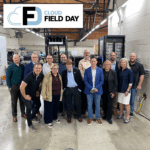|
|
 Brent Lim and David Stamen presented for Pure Storage at Cloud Field Day 24 |
The Enterprise Data Cloud with Pure Storage
Watch on YouTube
Watch on Vimeo
The Enterprise Data Cloud reimagines storage as a unified, software-driven environment—enabling organizations to manage data, not hardware. It brings together on-premises, cloud, and hybrid resources under a single intelligent control plane for consistent governance, automated protection, and seamless mobility. With built-in cyber resilience, SLA-driven performance, and real-time analytics, the Enterprise Data Cloud empowers enterprises to simplify operations, scale without disruption, and accelerate data-driven innovation.
Pure Storage presents an updated vision for the Enterprise Data Cloud, focusing on the shift from traditional siloed storage architectures to a more horizontal, virtualized, and automated approach. Legacy systems were characterized by individual arrays provisioned for specific workloads, leading to inefficient resource utilization and manual data governance. The modern data experience, in contrast, emphasizes resource pooling, virtualization, and automation, all managed through a unified control plane. This allows for consistent management of file, block, and object storage across on-premises, cloud, and hybrid environments.
The presentation highlighted key components of this vision, including Evergreen One (a consumption-based service), Purity (a unified data plane for block, file, and object storage), and Pure Fusion (intelligent automation of workflows). Evergreen One offers a scalable consumption model in which Pure Storage takes responsibility for meeting performance and capacity SLAs, including ransomware protection. Purity provides built-in data resilience, cybersecurity, and unified data services across various protocols and environments. Pure Fusion integrates with the Enterprise Data Cloud, delivering workload performance and scalability for enterprise and modern applications.
Ultimately, Pure Storage aims to deliver a unified, self-service, and scalable consumption model that abstracts the underlying storage infrastructure, allowing customers to focus on their data and applications. The Enterprise Data Cloud is designed to pool resources, virtualize data, and provide a consistent environment with built-in cyber resilience, data governance, and global scalability. The speakers emphasized that this approach simplifies virtualization support, provides built-in provisioning and disaster recovery, and offers Kubernetes-aware storage through Portworx.
Personnel: Brent Lim, David Stamen
Breaking Silos and Managing Data Across On-Premises and Cloud with Pure Storage
Watch on YouTube
Watch on Vimeo
Pure Fusion, built into the Purity operating environment, is a core enabler of the Enterprise Data Cloud architecture. Fusion federates arrays into a single, unified fleet and uses outcome-driven automation through Presets to ensure consistent provisioning and configuration of workloads across environments. The result: a self-service, API-driven platform that lets users manage data—not storage—across their hybrid cloud.
The presentation details the evolution of Pure Fusion to version 2, emphasizing its integration with Purity and its role in enabling the Enterprise Data Cloud architecture. A key goal is to shift the focus from managing storage infrastructure to managing data across on-premises and cloud environments. Fusion V2 prioritizes backward compatibility, allowing existing customers to leverage its benefits without requiring extensive script rewrites or retraining. Furthermore, it caters to “dark site” customers by integrating the control plane into Purity, eliminating the need for cloud connectivity while offering workload-placement recommendations through Pure One.
Fusion simplifies storage management through presets, which are declarative definitions of desired outcomes. Storage administrators and consumers can define their requirements in these presets, enabling Fusion to automate provisioning, configuration, and monitoring of workloads. The introduction of the “fleet” concept allows multiple arrays, including FlashArray, FlashBlade, and Pure Storage Cloud, to communicate and coordinate, enabling consistent application of presets across the entire data estate. This unified approach facilitates a shift from managing individual arrays to managing the fleet as a whole, streamlining operations and reducing the risk of misconfigurations.
The presentation showcased a demo of workload provisioning using presets, highlighting how junior administrators can easily deploy and configure databases with predefined settings, ensuring consistent, compliant configurations. The ability to tag resources with billing IDs facilitates chargeback and showback processes, while a compliance engine monitors for configuration drift and enables remediation. Also showcased was the potential of using Fusion with AI language models to automatically provision storage for Machine Learning training workloads. Fusion provides a framework for achieving objective-based management across multiple use cases, including MSPs, standardization, and provider-consumer separation.
Personnel: Brent Lim
Enterprise Storage for the Cloud – Simplify, Scale, and Save with Pure Storage
Watch on YouTube
Watch on Vimeo
Pure Storage Cloud brings enterprise-grade storage to the cloud with simplicity, resilience, and efficiency. This session dives into the technical foundations that deliver consistent performance and protection while helping organizations reduce costs across cloud migration, disaster recovery, and hybrid deployments.
David Stamen introduced Pure Storage Cloud as an update to their portfolio, emphasizing a shift towards a cloud-preferred model where data availability is paramount. The new portfolio includes Pure Storage Cloud Dedicated (formerly Cloud Block Store) and Pure Storage Cloud Azure Native Service, signifying a unified experience under a single control plane. Managed services are also a key component, catering to customers seeking hosted stacks within hyperscalers such as Azure VMware Solution and Elastic VMware Service, as well as in cloud-adjacent environments. This unified experience ensures consistent management and licensing, regardless of whether customers use Evergreen 1 or CapEx-based purchasing, all managed through Pure 1 with Purity.
The presentation addressed the challenges customers face when adopting the cloud, including rising costs, limited visibility, and overprovisioning due to bundled performance and capacity. To address these issues, Pure Storage Cloud offers a unified data plane with features such as data reduction (thin provisioning, deduplication, and compression), advanced replication options (synchronous, continuous, and periodic), built-in high availability, double data-at-rest encryption, and best-in-class snapshots. These capabilities aim to provide cost efficiency, performance optimization, and enhanced data protection, resolving the sprawl and management complexities associated with diverse cloud storage options.
A significant development highlighted was the Pure Storage Cloud Azure Native Service, which allows Pure Storage to build and operate a native service that integrates seamlessly with Azure. Key features include on-demand performance scaling, native integration with Azure services via a resource provider, and simplified deployment and management within the Azure portal. Plans include expanding support for Azure VMs, enabling easy connectivity configuration, and potentially integrating with other native services such as containerization platforms (e.g., Azure Kubernetes) and PaaS offerings.
Personnel: David Stamen








